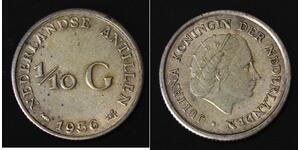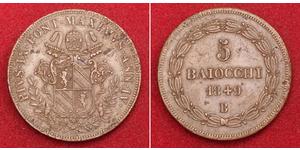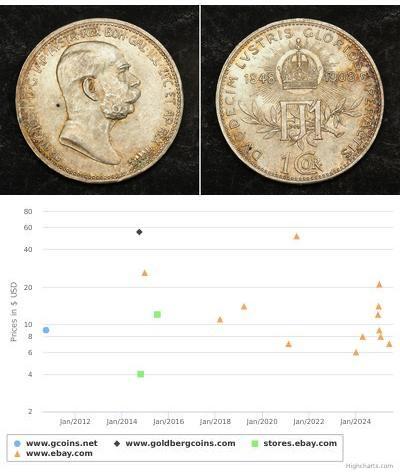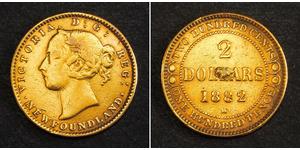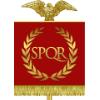1/2 Thaler
1791, Regensburg, Leopold II. Silver ½ Thaler Coin. Mint Year: 1791 Obverse: Laureated bust of Emperor Leopold II right. Initial (K) below bust. Reverse: City view of Regensburg seen from north with houses, city walls, cathedral, bridge, fortified gate and river depicted. Leopold was born in Vienna, a third son, and was at first educated for the priesthood, but the theological studies to which he was forced to apply himself are believed to have influenced his mind in a way unfavourable to the Church. On the death of his elder brother Charles in 1761, it was decided that he should succeed to his father’s grand duchy of Tuscany, which was erected into a “secundogeniture” or apanage for a second son. This settlement was the condition of his marriage on 5 August 1764 with Infanta Maria Luisa of Spain, daughter of Charles III of Spain and Maria Amalia of Saxony. On the death of his father Francis I (18 August 1765), he succeeded to the grand duchy. Leopold was famous in Florence for his numerous extra-marital affairs. Among his lovers was Countess Cowper, wife of the 3rd Earl Cowper, who in compensation for being cuckolded was given honors by Leopold’s brother Joseph II. For five years, he exercised little more than nominal authority, under the supervision of counsellors appointed by his mother. In 1770, he made a journey to Vienna to secure the removal of this vexatious guardianship and returned to Florence with a free hand. During the twenty years which elapsed between his return to Florence and the death of his eldest brother Joseph II in 1790, he was employed in reforming the administration of his small state. The reformation was carried out by the removal of the ruinous restrictions on industry and personal freedom imposed by his predecessors of the house of Medici and left untouched during his father’s life, by the introduction of a rational system of taxation, and by the execution of profitable public works, such as the drainage of the Val di Chiana. As he had no army to maintain, and as he suppressed the small naval force kept up by the Medici, the whole of his revenue was left free for the improvement of his state. Leopold was never popular with his Italian subjects. His disposition was cold and retiring. His habits were simple to the verge of sordidness, though he could display splendour on occasion, and he could not help offending those of his subjects who had profited by the abuses of the Medicean régime. But his steady, consistent, and intelligent administration, which advanced step by step, brought the grand duchy to a high level of material prosperity. His ecclesiastical policy, which disturbed the deeply rooted convictions of his people and brought him into collision with the pope, was not successful. He was unable to secularize the property of the religious houses or to put the clergy entirely under the control of the lay power. However, his abolition of Capital Punishment was the first permanent abolition in modern times. On 30 November 1786, after having de facto blocked capital executions (the last was in 1769), Leopold promulgated the reform of the penal code that abolished the death penalty and ordered the destruction of all the instruments for capital execution in his land. Torture was also banned. In 2000 Tuscany’s regional authorities instituted an annual holiday on 30 November to commemorate the event. The event is also commemorated on this day by 300 cities around the world celebrating the Cities for Life Day. Leopold also approved and collaborated on the development of a political constitution, said to have anticipated by many years the promulgation of the French constitution and which presented some similarities with the Virginia Bill of Rights of 1778. Leopold’s concept of this was based on respect for the political rights of citizens and on a harmony of power between the executive and the legislative. However, it could not be put into effect because Leopoldo moved to Vienna to become emperor in 1790, and because it was so radically new that it garnered opposition even from those who might have benefitted from it. However, Leopold developed and supported many social and economic reforms. Smallpox vaccination was made systematically available, and an early institution for the rehabilitation of juvenile delinquents was founded. Leopold also introduced radical reforms to the system of neglect and inhumane treatment of those deemed mentally ill. On 23 January 1774, the “legge sui pazzi” (law on the insane) was established, the first of its kind to be introduced in all Europe, allowing steps to be taken to hospitalize individuals deemed insane. A few years later Leopold undertook the project of building a new hospital, the Bonifacio. He used his skill at choosing collaborators to put a young physician, Vincenzo Chiarugi, at its head. Chiarugi and his collaborators introduced new humanitarian regulations in the running of the hospital and caring for the mentally ill patients, including banning the use of chains and physical punishment, and in so doing have been recognized as early pioneers of what later came to be known as the moral treatment movement. During the last few years of his rule in Tuscany, Leopold had begun to be frightened by the increasing disorders in the German and Hungarian dominions of his family, which were the direct result of his brother’s headlong methods. He and Joseph II were tenderly attached to one another and met frequently both before and after the death of their mother. The portrait by Pompeo Batoni in which they appear together shows that they bore a strong personal resemblance to one another. But it may be said of Leopold, as of Fontenelle, that his heart was made of brains. He knew that he must succeed his childless eldest brother in Austria, and he was unwilling to inherit his unpopularity. When, therefore, in 1789 Joseph, who knew himself to be dying, asked him to come to Vienna and become co-regent, Leopold coldly evaded the request. He was still in Florence when Joseph II died at Vienna on 20 February 1790, and he did not leave his Italian capital until 3 March 1790. Leopold, during his government in Tuscany, had shown a speculative tendency to grant his subjects a constitution. When he succeeded to the Austrian lands, he began by making large concessions to the interests offended by his brother’s innovations. He recognized the Estates of his different dominions as “the pillars of the monarchy”, pacified the Hungarians and Bohemians, and divided the insurgents in the Austrian Netherlands (now Belgium) by means of concessions. When these failed to restore order, he marched troops into the country and re-established his own authority, and at the same time the historic franchises of the Flemings. Yet he did not surrender any part that could be retained of what Maria Theresa and Joseph had done to strengthen the hands of the state. He continued, for instance, to insist that no papal bull could be published in his dominions without his consent (placetum regium). One of the harshest actions Leopold took to placate the noble communities of the various Habsburg domains was to issue a decree on 9 May 1790, that forced thousands of Bohemian serfs freed by his brother Joseph back into servitude. If Leopold’s reign as emperor and king of Hungary-Croatia and Bohemia had been prolonged during years of peace, it is possible that he would have repeated his successes as a reforming ruler in Tuscany on a far larger scale. But he lived for barely two years, and during that period he was hard pressed by peril from west and east alike. The growing revolutionary disorders in France endangered the life of his sister Marie Antoinette of Austria, the queen of Louis XVI, and also threatened his own dominions with the spread of a subversive agitation. His sister sent him passionate appeals for help, and he was pestered by the royalist emigrants, who were intriguing to bring about armed intervention in France. From the east he was threatened by the aggressive ambition of Catherine II of Russia and by the unscrupulous policy of Prussia. Catherine would have been delighted to see Austria and Prussia embark on a crusade in the cause of kings against the French Revolution. While they were busy beyond the Rhine, she would have annexed what remained of Poland and made conquests against the Ottoman Empire. Leopold II had no difficulty in seeing through the rather transparent cunning of the Russian empress, and he refused to be misled. To his sister, he gave good advice and promises of help if she and her husband could escape from Paris. The emigrants who followed him pertinaciously were refused audience, or when they forced themselves on him, were peremptorily denied all help. Leopold was too purely a politician not to be secretly pleased at the destruction of the power of France and of her influence in Europe by her internal disorders. Within six weeks of his accession, he displayed his contempt for her weakness by practically tearing up the treaty of alliance made by Maria Theresa in 1756 and opening negotiations with England to impose a check on Russia and Prussia. He was able to put pressure on England by threatening to cede his part of the Low Countries to France. Then, when sure of English support, he was in a position to baffle the intrigues of Prussia. A personal appeal to Frederick William II led to a conference between them at Reichenbach in July 1790, and to an arrangement which was in fact a defeat for Prussia: Leopold’s coronation as king of Hungary on 11 November 1790, preceded by a settlement with the diet in which he recognized the dominant position of the Magyars. He had already made an eight months' truce with the Turks in September, which prepared the way for the termination of the war begun by Joseph II, the peace of Sistova being signed in August 1791. The pacification of his eastern dominions left Leopold free to re-establish order in Belgium and to confirm friendly relations with England and Holland. During 1791, the emperor continued to be increasingly preoccupied with the affairs of France. In January, he had to dismiss the Count of Artois, afterwards Charles X, king of France, in a very peremptory way. His good sense was revolted by the folly of the French emigrants, and he did his utmost to avoid being entangled in the affairs of that country. The insults inflicted on Louis XVI and Marie Antoinette, however, at the time of their attempted flight to Varennes in June, stirred his indignation, and he made a general appeal to the sovereigns of Europe to take common measures in view of events which “immediately compromised the honour of all sovereigns, and the security of all governments.” Yet he was most directly interested in the conference at Sistova, which in June led to a final peace with Turkey. On 25 August 1791, he met the king of Prussia at Pillnitz, near Dresden, and they drew up a declaration of their readiness to intervene in France if and when their assistance was called for by the other powers. The declaration was a mere formality, for, as Leopold knew, neither Russia nor England was prepared to act, and he endeavoured to guard against the use which he foresaw the emigrants would endeavour to make of it. In face of the agitation caused by the Pillnitz declaration in France, the intrigues of the emigrants, and the attacks made by the French revolutionists on the rights of the German princes in Alsace, Leopold continued to hope that intervention might not be required. When Louis XVI swore to observe the constitution of September 1791, the emperor professed to think that a settlement had been reached in France. The attacks on the rights of the German princes on the left bank of the Rhine, and the increasing violence of the parties in Paris which were agitating to bring about war, soon showed, however, that this hope was vain. Leopold meant to meet the challenge of the revolutionists in France with dignity and temper, however the effect of the Declaration of Pillnitz was to contribute to the radicalization of their political movement. He died suddenly in Vienna, in March 1792. Like his parents before him, Leopold had sixteen children, the eldest of his eight sons being his successor, the Emperor Francis II. Some of his other sons were prominent personages in their day. Among them were: Ferdinand III, Grand Duke of Tuscany; the Archduke Charles of Austria, a celebrated soldier; the Archduke Johann of Austria, also a soldier; the Archduke Joseph, Palatine of Hungary; and the Archduke Rainer, Viceroy of Lombardy-Venetia. Mozart’s opera La clemenza di Tito was commissioned by the Estates of Bohemia to be included among the festivities that accompanied Leopold’s coronation as king of Bohemia in Prague on 6 September 1791.

Mintage: 1,446 pcs.
Reference: KM-463. R!
Denomination: ½ Thaler
Mint Official: Georg Christoph Busch (G.C.B.)
Mint Place: Regensburg (as a Free Imperial City)
Condition: Certified and graded by PCGS as AU (Tooled – referring to the small, but deep scratches in the reverse!)
Diameter: 35mm
Material: Silver
Weight: 14gm
Legend: LEOPOLDVS . II . D . G . ROM . IMP . S . A .
Exergue: K
Legend: MONETA REIP RATISPON
Exergue: XX . ST . EINE F . C . M / 1791 / G. C. B. From 1663 to 1806, the Regensburg was the permanent seat of the Reichstag of the Holy Roman Empire. Thus Regensburg was one of the central towns of the Empire, attracting visitors in large numbers. In 1803 the city lost its status as a free city. It was handed over to the Archbishop of Mainz and Archchancellor of the Holy Roman Empire Carl von Dalberg in compensation for Mainz, which had become French under the terms of the Treaty of Lunéville in 1801. The archbishopric of Mainz was formally transferred to Regensburg. Dalberg united the bishopric, the monsteries and the town itself, making up the Principality of Regensburg (Fürstentum Regensburg). Dalberg strictly modernised public life. Most importantly he awarded equal rights to Protestants and Roman Catholics. In 1810 Dalberg ceded Regensburg to the Kingdom of Bavaria, he himself being compensated by the towns of Fulda and Hanau being given to him under the title of “Grand Duke of Frankfurt”.
From 1663 to 1806, the Regensburg was the permanent seat of the Reichstag of the Holy Roman Empire. Thus Regensburg was one of the central towns of the Empire, attracting visitors in large numbers. In 1803 the city lost its status as a free city. It was handed over to the Archbishop of Mainz and Archchancellor of the Holy Roman Empire Carl von Dalberg in compensation for Mainz, which had become French under the terms of the Treaty of Lunéville in 1801. The archbishopric of Mainz was formally transferred to Regensburg. Dalberg united the bishopric, the monsteries and the town itself, making up the Principality of Regensburg (Fürstentum Regensburg). Dalberg strictly modernised public life. Most importantly he awarded equal rights to Protestants and Roman Catholics. In 1810 Dalberg ceded Regensburg to the Kingdom of Bavaria, he himself being compensated by the towns of Fulda and Hanau being given to him under the title of “Grand Duke of Frankfurt”.

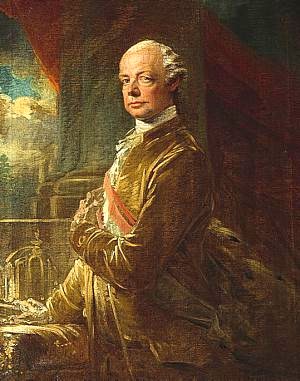 Leopold II (5 May 1747 – 1 March 1792), born Peter Leopold Joseph Anton Joachim Pius Gotthard, was Holy Roman Emperor from 1790 to 1792, King of Hungary, archduke of Austria, and Grand Duke of Tuscany from 1765 to 1790. He was a son of Emperor Francis I and his wife, Empress Maria Theresa. Leopold was a moderate proponent of enlightened absolutism.
Leopold II (5 May 1747 – 1 March 1792), born Peter Leopold Joseph Anton Joachim Pius Gotthard, was Holy Roman Emperor from 1790 to 1792, King of Hungary, archduke of Austria, and Grand Duke of Tuscany from 1765 to 1790. He was a son of Emperor Francis I and his wife, Empress Maria Theresa. Leopold was a moderate proponent of enlightened absolutism.
(1537 X 741 pixels, file size: ~328K)
Posted by: anonymous 2023-10-29
1791, Regensburg, Leopold II. Silver ½ Thaler Coin. 1,446 pcs. Struck! PCGS AU+ Mint Year: 1791Mintage: 1,446 pcs.Reference: KM-463. R! Denomination: ½ ThalerMint Official: Georg Christoph Busch (G.C.B.)Mint Place: Regensburg (as a Free Imperial City) Condition: Certified and graded b ...
(1365 X 652 pixels, file size: ~207K)
Posted by: anonymous 2017-07-17
1791, Regensburg (Free City), Leopold II. Silver "City-View" 1/2 Thaler Coin. R! Mint year: 1791 Mintage: 1,446 pcs. Denomination: ½ Thaler Reference: KM-463. R! Mint Official: Georg Christoph Busch (G.C.B.) Mint Place: Regensburg (as a Free Imperial City) Condition: Lightly smo ...
2 Dollar Canada Gold Victoria (1819 - 1901)
group has 39 coins / 38 prices
⇑








